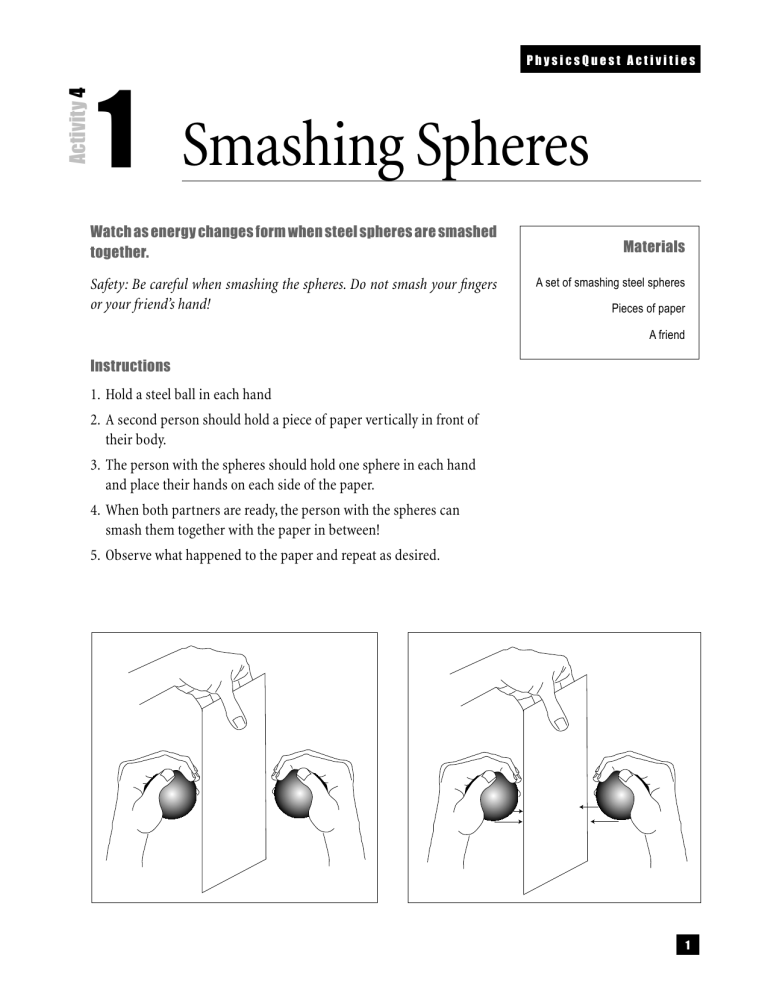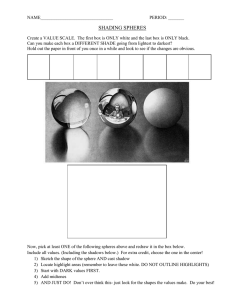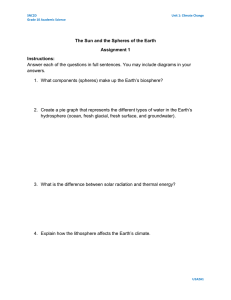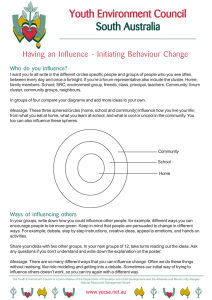Activity 4 - Physics Central

1
Watch as energy changes form when steel spheres are smashed together.
Safety: Be careful when smashing the spheres. Do not smash your fingers or your friend’s hand!
P h y s i c s Q u e s t A c t i v i t i e s
Smashing Spheres
Materials
A set of smashing steel spheres
Pieces of paper
A friend
Instructions
1. Hold a steel ball in each hand
2. A second person should hold a piece of paper vertically in front of their body.
3. The person with the spheres should hold one sphere in each hand and place their hands on each side of the paper.
4. When both partners are ready, the person with the spheres can smash them together with the paper in between!
5. Observe what happened to the paper and repeat as desired.
1
page 2 • PhysicsQuest • Extension Activities
Discussion Questions
What happened to the paper after the spheres were smashed? Is this what you expected?
What do you think caused this result? Where did the energy come from to cause this change?
What might happen if you used thicker paper or different sized spheres in this experiment? Why?
List some other types of energy. Use examples from your experience.
1 P h y s i c s Q u e s t A c t i v i t i e s
FOR THE TEACHER
Smashing Spheres
Discussion
The smashing spheres provided in the kit from Educational Innovations,
Inc. weigh one pound and are two inches in diameter. When smashed together, the energy from their motion is converted into enough heat to burn a hole in a piece of paper!
In this experiment kinetic energy is converted into thermal energy, or heat, which causes the paper to burn at the place of contact. Some energy from the balls’ motion is also converted into sound waves as the spheres collide, which results in the loud crack you and your students hear.
The energy in the system (spheres and paper) is initially in the form of kinetic energy, or the energy of motion. In this case the kinetic energy is in the form of translational motion, since the entire sphere is moving toward the paper. Kinetic motion can also be vibrational, as in molecules vibrating within a material, or rotational, like when a wheel spins around its own center while the entire wheel does not change its position.
When the two spheres collide they stop, which means they no longer have translational kinetic energy. This energy must go somewhere because energy is conserved overall. Some of the energy from the collision is converted to thermal energy, or heat. This heat changes the temperature of the paper and warms it enough to burn a small hole. The rest of the energy creates sound waves, which we hear as a crack. Some energy may also remain in the balls and cause them to vibrate when they collide.
The smashing spheres are just one example of conversion from one form of energy to another. To extend the concept of conservation of energy farther you may wish to discuss where the energy one partner used to move the spheres came from. The food chain can be used to illustrate that our energy comes from food, while the energy in our food comes from plants and ultimately from the Sun.
Materials
A set of smashing steel spheres
Smashing steel spheres may be purchased from
Educational Innovations,
Inc. here: http://www.
teachersource.com/Energy/
EnergyConversion/Smashing_
SteelSphereDemoKit.aspx
Pieces of paper
A friend
Extension Activities • PhysicsQuest • page 3
page 4 • PhysicsQuest • Extension Activities
Suggested Resources
Smashing steel spheres may be purchased from Educational
Innovations, Inc. here: http://www.teachersource.com/Energy/EnergyConversion/Smashing_
SteelSphereDemoKit.aspx
Mechanical Energy: http://en.wikipedia.org/wiki/Mechanical_energy
2
Cold Wave
Observe a chemical reaction that lowers the temperature of water.
Safety: Be careful when handling the Epsom salt solution.
Instructions:
1. Wash the glass jar thoroughly and then fi ll it ¾ of the way with tap water. Allow the jar to sit for a few minutes so it can reach room temperature.
2. Feel the sides of the jar and take note of the temperature.
3. Place the thermometer inside the jar and wait for a couple of minutes. Record the temperature of the water in the jar.
P h y s i c s Q u e s t A c t i v i t i e s
Materials
Thermometer
Epsom Salt
Tap water
Spoon
Medium glass jar
Pencil and paper
4. Use the spoon to carefully add 4 spoonfuls of Epsom salt to the water.
Being careful to avoid hitting the thermometer, stir the solution until the salt is completely dissolved.
5. Feel the sides of the jar and then record the temperature of the water.
1
page 2 • PhysicsQuest • Extension Activities
Discussion Questions
What happened to the temperature of the water inside the jar?
Is heat absorbed or produced by this reaction?
Where did the heat go?
What uses can you think of for this solution?
2
FOR THE TEACHER
Cold Wave
Discussion
When the Epsom salts are added to the room temperature water, a chemical reaction takes place. This reaction absorbs heat from the water, so the water gets colder. The heat is used to break the bonds in the salt. Such a reaction, where heat is absorbed and cools the surroundings, is call endothermic. Students can remember this word because “endo-” means
“inside” and “-thermic” means “heat” so the heat goes in from the surroundings.
Epsom salt baths are used for several medical purposes. Many people soak their feet in an Epsom salt bath to reduce soreness and swelling due to athletic injury or for improvement in circulation and nerve function.
The low temperature bath helps to absorb heat from the injury while allowing the healing process to take place.
Some other examples of endothermic processes reactions include combining vinegar and baking soda, as in many science projects simulating volcanoes, and photosynthesis, the process by which plants produce food. In both of these, just like in the experiment, heat goes into the materials reacting (vinegar and baking soda solution in the case of the first reaction, and the plant in photosynthesis) and the surrounding material gets colder.
P h y s i c s Q u e s t A c t i v i t i e s
Materials
Thermometer
(Included in PhysicsQuest kit)
Epsom Salt
Tap water
Spoon
Medium glass jar
(canning jars, pasta sauce jars, or beakers work well)
Extension Activities • PhysicsQuest • page 3
page 4 • PhysicsQuest • Extension Activities
Suggested Resources
Endothermic: http://en.wikipedia.org/wiki/Endothermic
Examples of Endothermic Processes: http://antoine.frostburg.edu/chem/senese/101/thermo/faq/exothermicendothermic-examples.shtml
Bibliography
Churchill, E. Richard, Loeschnig, Louis V., Mandell, Muriel, “365 Simple
Science Experiments with Everyday Materials,” Sterling Publishing
Company.





